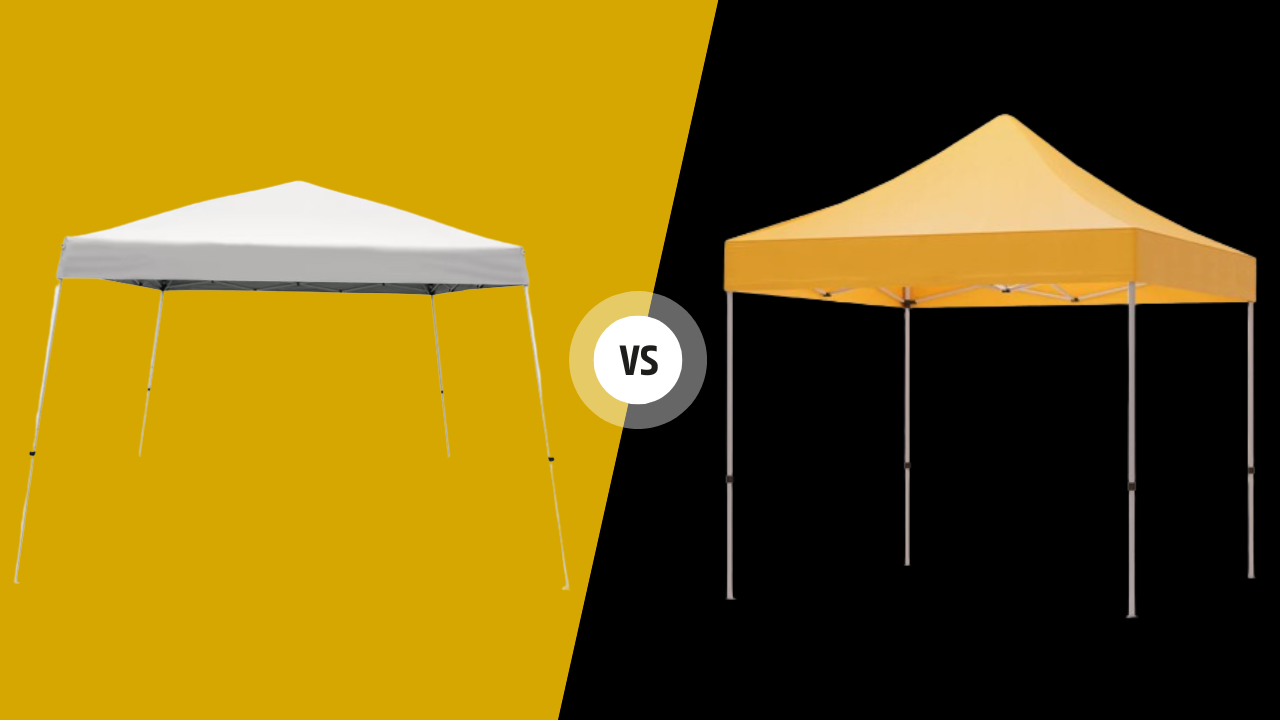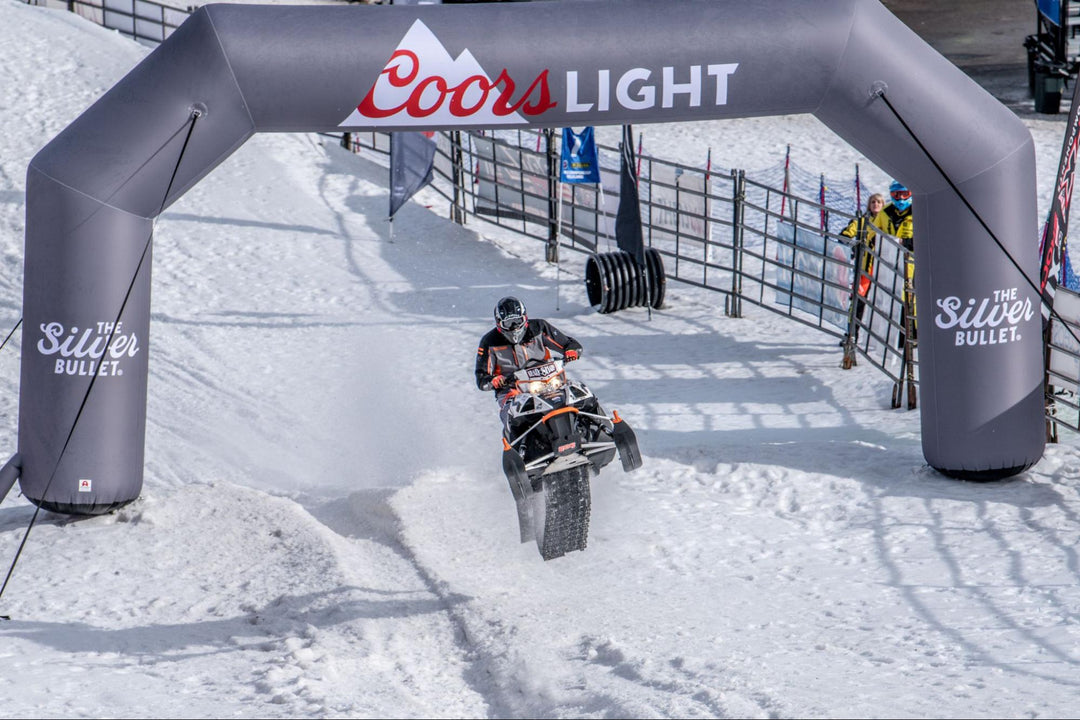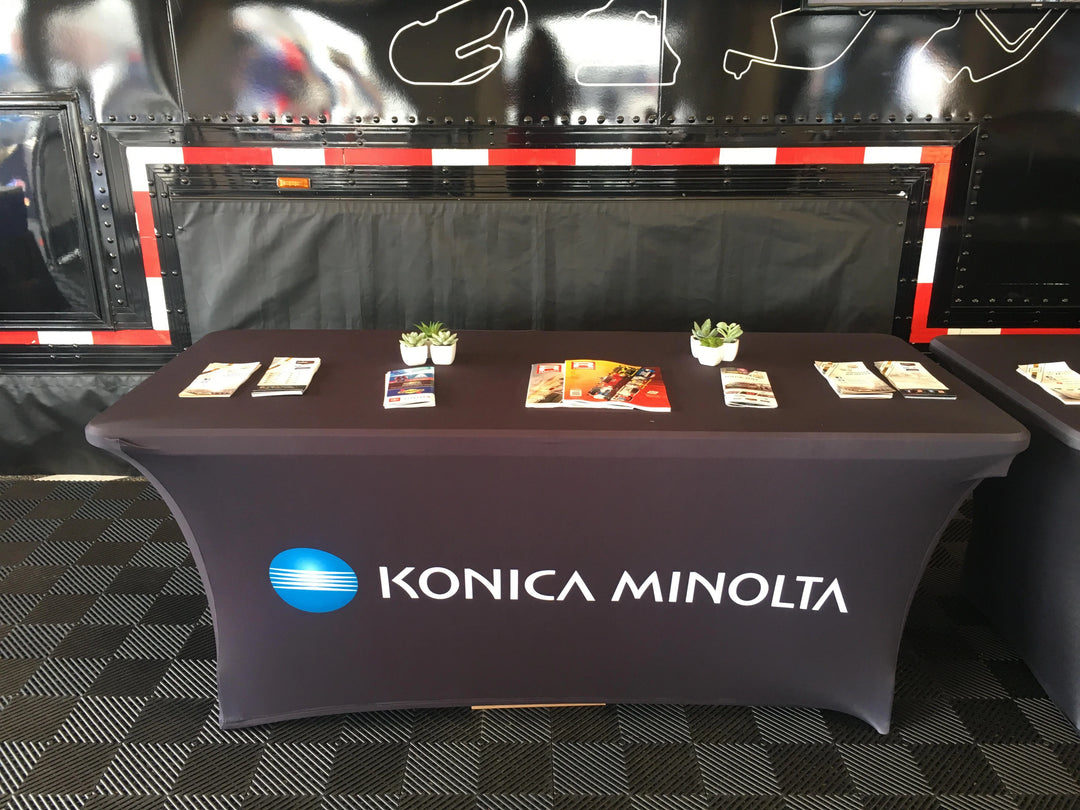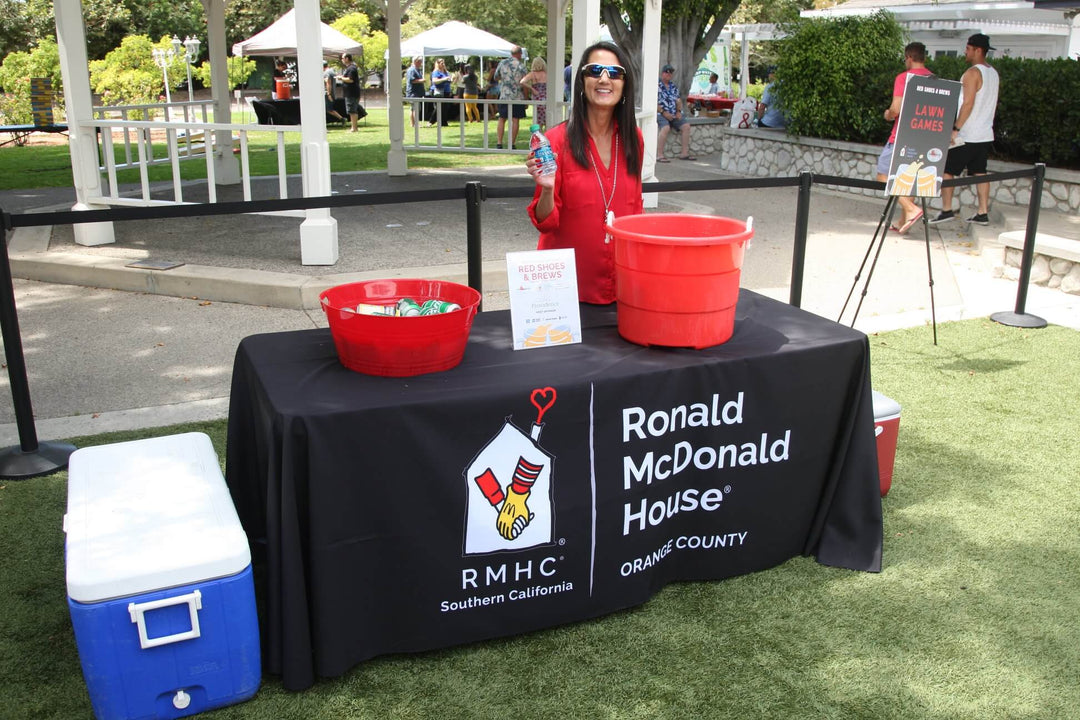Are you trying to decide which is better, straight vs slant leg canopy tent?
Whether you're a farmer's market vendor, setting up for a trade show, or hosting a craft fair, selecting the right leg type can make a significant difference. The right choice not only enhances the functional aspects of your setup but also plays a crucial role in branding and customer engagement.
Spoiler alert: for commercial use, straight leg canopies offer clear advantages in terms of stability, coverage, and brand visibility, making them the preferred choice for businesses looking to make an impact.
In our comprehensive comparison, we've evaluated essential elements including customizability, coverage area, stability, durability, cost-effectiveness, and the ease of setup. This analysis is designed to guide you in making an informed choice between straight and slant leg canopies, tailored to meet your specific needs.
1. Customizability
When it comes to the customizability of canopies, it's all about flexibility and adaptability. The design is a big factor here – it's not just about the simplicity of adding a few bells and whistles. What really matters is how these structures can transform to meet evolving needs on the fly.
We're talking frameworks allowing on-site modifications for spur-of-the-moment staging, shifting brand messaging over campaigns, and future growth scenarios. Investing in customization-friendly foundations enables canopies to go the distance through long-term use.

The straight leg custom canopy tent offers numerous customization possibilities, like attaching side half walls and full banners on the rear.
Let's explore how slant leg and straight leg canopies fare in this regard.
Slant Leg Canopies
- Distinctive Design: The unique angled design provides a stylistic edge, but it can also limit customizability.
- Attachment Challenges: Attaching additional elements like sidewalls or custom branding materials is often more challenging due to the angled structure.
- Suitability: Best suited for basic use cases where minimal customization is required or when aesthetic design is the primary concern.
Straight Leg Canopies
- Ease of Customization: The vertical design simplifies the addition of accessories, making these canopies highly customizable.
- Accessory Compatibility: Easily accommodates full and half sidewalls, which is beneficial for businesses and organizations at promotional events.
- Versatility for Commercial Use: Ideal for displaying branding and promotional materials, offering practical solutions for customizable and functional outdoor spaces.
Verdict
Straight leg canopies emerge as the superior choice in terms of customizability. Their design accommodates a wider range of modifications and additions, aligning perfectly with the needs of businesses and events where adaptability and branding are crucial.
2. Coverage
When considering the effectiveness of a canopy, one of the most crucial factors is its coverage area – how much space it actually provides shelter and shade for.
This aspect becomes particularly significant when evaluating canopies for events, outdoor activities, or commercial purposes where maximizing usable space is essential.

The straight leg brandable 10x20 canopy for food vendors provides a full 200 square feet of space, compared to the 160 square feet provided by the slant leg canopy.
In this section, we'll compare the actual coverage provided by 10x10 and 10x20 models of slant leg and straight leg canopies to see which design offers more effective space utilization.
10x10 Canopies
- Slant Leg Canopies: The footprint is 10x10, but due to the slant, the actual coverage is less. Typically, the coverage might be around 8x8 or 64 square feet, as the slant reduces the effective shaded area under the canopy.
- Straight Leg Canopies: A 10x10 straight leg canopy provides a full 100 square feet of coverage, as the vertical legs mean the canopy's footprint matches the coverage area.
10x20 Canopies
- Slant Leg Canopies: Similar to the 10x10 model, a 10x20 slant leg canopy will have reduced coverage due to the angle of the legs. The actual coverage might be around 8x20 or 160 square feet, depending on the degree of the slant.
- Straight Leg Canopies: A 10x20 straight leg canopy would offer a full 200 square feet of coverage, maintaining the ratio of the footprint to the coverage area.
Verdict
Straight leg canopies provide more actual coverage compared to slant leg canopies. For both 10x10 and 10x20 sizes, the straight leg design ensures that the entire area beneath the canopy is usable, making them more efficient for space utilization. This is particularly important in settings where maximizing the shaded or sheltered area is crucial.
3. Stability / Structural Integrity
Stability and structural integrity are paramount for canopies, especially when they are used in outdoor environments subject to varying weather conditions. In this section, we will examine how the structural designs of slant leg and straight leg canopies influence their stability and ability to withstand wind, addressing the question of the best canopy for windy conditions.

MVP Visual's 10 by 10 straight leg canopy offers superb stability, especially when the tent leg weight bags are secured to the base.
By understanding the physics and engineering principles behind each design, we can better assess which type of canopy offers more reliability and safety in practical scenarios.
Slant Leg Canopies
Slant leg canopies have a distinctive design where the legs extend outward at an angle from the top. This unique structure, while visually appealing, impacts their stability in several ways:
- Force Distribution: The angled legs cause wind forces to be distributed across both vertical and horizontal planes, leading to a torque effect that can make the canopy more prone to twisting or tilting.
- Center of Gravity and Base Support: The narrower effective base of these canopies results in a higher center of gravity, which can decrease stability. This is crucial in structural engineering, where stability is often a function of the base area relative to the height and center of gravity.

- Practical Implication: Due to the reduced effective base area and higher center of gravity, slant leg canopies might require extra anchoring or strategic placement to ensure stability, especially in windy conditions.
Straight Leg Canopies
Straight leg canopies feature legs that extend vertically downward, forming a right angle with the ground. This design significantly influences their stability:
- Direct Force Transmission: The vertical alignment allows wind forces to be transmitted more directly down the legs into the ground. This reduces lateral stress and minimizes the potential for the canopy to tip over.
- Improved Stability through Design: With a broader base and a lower center of gravity, these canopies are inherently more stable. The larger base area and vertical alignment enhance stability.
- Advantage in Wind Resistance: The straight leg design efficiently absorbs and distributes wind forces, following the principle Force = Mass x Acceleration. This makes straight leg canopies more resistant to wind and less likely to deform under stress, making them a more reliable choice in varied conditions.
Verdict
Based on structural engineering principles, straight leg canopies outperform slant leg canopies in terms of stability and wind resistance. Their design ensures a more effective distribution of forces, offering greater inherent stability, especially in challenging weather conditions.
4. Durability
In evaluating canopies, durability is a critical factor that directly impacts their longevity and effectiveness over time. Durability depends largely on the structural design of the canopy, the distribution of stress points, and the materials used in construction.
MVP Visuals custom tents feature aluminum legs with a hexagonal profile, backed by lifetime warranty.
Let’s dive into how the design of slant leg and straight leg canopies influences their durability, particularly in terms of structural integrity, material quality, and their ability to withstand environmental stresses such as wind, rain, and snow.
Slant Leg Canopies
- Structural Stress Points: The angled design of slant leg canopies introduces unique stress points where the legs meet the canopy. These points bear more stress during use, especially under windy conditions or when bearing weight, like rain or snow accumulation.
- Material Considerations: Often, the materials used need to be lightweight to compensate for the additional stress caused by the angle, which can sometimes mean a compromise in material strength or thickness.
- Lifespan Implications: Over time, the combination of structural stress and potentially lighter materials may lead to quicker wear and tear. This could mean a shorter lifespan for slant leg canopies compared to straight leg designs, especially in harsh weather conditions.
Straight Leg Canopies
- Even Stress Distribution: The vertical legs of straight leg canopies support the canopy's weight more evenly. This reduces stress on any single point, leading to less strain on the joints and connectors.
- Robust Material Use: The ability to evenly distribute stress allows for the use of more robust materials without the risk of excess strain. This often translates into stronger frames and more durable canopy materials.
- Longevity Benefits: The combination of a more stable structural design and stronger materials typically results in a longer lifespan for straight leg canopies. They are generally better equipped to withstand varied weather conditions and frequent use.
Verdict
Straight leg canopies offer better durability due to their structural design. The vertical leg structure allows for a more even distribution of stress and the use of stronger materials, contributing to a longer lifespan and greater resilience in various conditions.
5. Affordability
When it comes to choosing a canopy, the cost is often a deciding factor. Affordability varies significantly between slant leg and straight leg canopies, primarily due to differences in their construction and the materials used.
This section aims to shed light on these price variations, offering insights into which option might be more cost-effective based on their design and material considerations.
Slant Leg Canopies
- Reduced Material Use: The construction of slant leg canopies typically requires less material, particularly in the frame and overall structure.
- Lower Cost: Due to the reduced amount of material and simpler design, slant leg canopies are generally more affordable. The savings in material costs are passed on to the consumer, making these canopies a more budget-friendly choice.
Straight Leg Canopies
- More Material and Robust Design: Straight leg canopies use more material in both the frame and the canopy itself. This increased material usage contributes to a more robust construction.
- Higher Pricing: The additional material and construction complexity result in higher costs for straight leg canopies. While specific prices may vary by brand and features, they are typically more expensive than slant leg canopies, sometimes by a significant margin.
Verdict
Slant leg canopies are the more affordable option, catering to budget-conscious buyers. Straight leg canopies, though more expensive, justify their price with a robust design and potentially greater longevity. This choice between affordability and durability is a key consideration for consumers.
6. Portability and Ease of Setup
When selecting a canopy, the ease with which it can be transported and set up is a crucial factor, especially for those who plan to use their canopy in various locations. This section compares slant leg and straight leg canopies in terms of their portability and the simplicity of their setup process.
Slant Leg Canopies
- Lighter Weight: Generally, slant leg canopies are lighter due to using less material in their construction. This makes them easier to transport, particularly for individuals or small groups.
- Compact Design: The angled structure often allows for a more compact fold, taking up less space in storage and transportation.
- Ease of Setup: Typically, slant leg canopies are designed for quick and easy setup, ideal for casual use like picnics, beach outings, or small vendor booths. However, the unique design might require careful attention to ensure stability during setup.
Straight Leg Canopies
- Heavier and Bulkier: Due to the use of more material and a more robust construction, straight leg canopies tend to be heavier and bulkier. This might necessitate additional help or more effort in transportation.
- Larger Storage Space: Their design, while offering more coverage, often results in a larger packed size, requiring more storage space.
- Setup Complexity: Although modern straight leg canopies are designed for relatively straightforward assembly, they might require more time and effort to set up compared to slant leg canopies. This is especially true for larger models used in commercial settings.
Verdict
Slant leg canopies offer greater portability and are generally easier to set up, making them a suitable choice for casual or personal use. Straight leg canopies, while less portable and requiring more effort to set up, provide a sturdier and more stable structure, which is essential for commercial use.
Commercial Use Comparison: Slant Leg vs. Straight Leg Canopies
For businesses evaluating canopy tents for events, promotional activities, or outdoor operations, understanding the key differences between slant leg and straight leg canopies is crucial.
The following table breaks down key aspects of each canopy type, focusing on elements that matter most in a commercial context.

| Criteria | Slant Leg Canopies | Straight Leg Canopies |
| Customizability | Limited; challenging for branding | Highly customizable; ideal for branding |
| Coverage | Less space; may affect customer flow | More space; better for customer engagement |
| Stability/Integrity | Requires additional setup for stability | Inherently stable; suitable for varied conditions |
| Durability | Less durable; may require frequent replacement | More durable; withstands frequent use |
| Affordability | Budget-friendly; initial lower cost | Higher upfront cost; long-term value |
| Portability & Setup | Easier to transport; setup may be less stable | Heavier; stable setup ideal for ongoing use |
| Brand Visibility | Limited scope for large-scale branding | Better visibility; more area for promotional material |
Final Verdict: Straight Leg Canopies for Commercial Superiority
In the comparison between slant leg and straight leg canopy for business purposes, straight leg canopy is the clear winner. Their exceptional customizability enables superior branding opportunities, increasing brand visibility and impact in various settings.
Straight leg canopies also excel in terms of space and coverage. They provide a broader usable area, which is crucial for environments like trade shows and conventions.
Furthermore, straight leg canopies are known for their stability and durability. They withstand various conditions and are built for longevity, making them a dependable choice for businesses. Their durability translates to a longer lifespan and the need for fewer replacements, ensuring cost-effectiveness and a wise investment for businesses.
For companies seeking a blend of functionality, long-term value, and audience engagement, straight leg canopies are the superior choice vs slant leg canopies.



